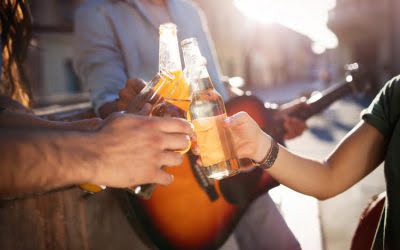We planned on conducting sensitivity analyses on studies based on their level of risk of bias (high‐risk studies versus low‐risk studies). Most of the included studies had similar risk of bias across all domains except for performance bias and detection bias, for which risk arises from blinding of participants, personnel, and outcome assessors. So, we decided to conduct a sensitivity analysis of the included studies based on the blinding condition (Table 7). We observed a greater reduction in blood pressure after a moderate dose of alcohol consumption for the unblinded studies, which was probably due to the presence of a heterogeneous population.
- Alcohol increases blood levels of the hormone renin, which causes the blood vessels to constrict.
- The vagus nerve is a component of the parasympathetic nervous system and is largely responsible for regulation of the heart rate at rest.
- You should never consider wine or any other alcohol as a way to lower your heart disease risk.
- Plasma renin activity was reported to be increased in Kawano 2000 as a late effect of alcohol consumption.
3Greenfield and colleagues (2005) studied the effects of alcohol at meal time in a group of nonsmoking, healthy postmenopausal women. Each woman was given either no alcohol or 15 g of alcohol (1 standard drink) with either a low-carbohydrate or a high-carbohydrate, high-fat meal. The researchers found that the alcohol-drinking subjects (particularly those who were insulin does alcohol affect bp sensitive) had higher insulin levels and a slower rise in glucose levels after a low-carb meal. They recommended confirming these results in younger women and in men, particularly since their subjects had been older women, who have more significant cardiovascular risk. Through the process of oxidative phosphorylation, the mitochondria generate ~90 percent of cellular ATP.
Vena 2018b published data only
At the end of the study period, researchers noted a decrease in systolic blood pressure and diastolic blood pressure in 94 people with untreated high blood pressure or prehypertension. This increase in heart rate can also lead to “holiday heart syndrome,” Dr. Mintz says. “In the 24 to 48 hours after you drink, you can experience irregular heartbeats.” This was first noticed in emergency rooms after New Year’s Eve, a night known for celebratory — and sometimes excessive — alcohol consumption. In humans, endothelial function is assessed by measuring the widening (i.e., dilation) of the brachial artery under different conditions.

“Specifically, when you’re younger, your brain is going through a lot of changes. A huge risk factor for people who develop alcohol use disorder is early-onset drinking. So, if you drink before the age of 14, there’s about a 50% chance you’re going to develop an alcohol use disorder in your adulthood,” explains Dr. Anand.
Understanding the Connection Between Alcohol and Blood Pressure
Both experimental approaches also prevented accumulation of ethanol-induced scarring (collagen and fibronectin); apoptotic cell death; and changes in the size, shape, and function of the heart after injury to heart muscle (ventricular remodeling). Several reports indicate that alcohol first exerts a seemingly positive effect, followed by a more negative impact (i.e., it is biphasic) on the endothelial–nitric oxide–generating system. Endothelial dysfunction is an early indicator of blood vessel damage and atherosclerosis, as well as a strong prognostic factor for future CV events (Deanfield et al. 2007; Ras et al. 2013). Low-to-moderate levels of alcohol consumption may initially improve endothelial function, whereas high daily levels and binge drinking may impair it.
The Relationship Between Dehydration and Blood Pressure – Men’s Health
The Relationship Between Dehydration and Blood Pressure.
Posted: Thu, 24 Aug 2023 07:00:00 GMT [source]
We also did not rate the certainty of evidence based on the funding sources of studies or on lack of a registered protocol because we did not think this would affect the effect estimates for these outcomes. However, we noted the lack of description of randomisation and allocation concealment methods in most of the included studies as a reason for downgrading because of the possibility of selection bias. Rosito 1999 reported the effects of 15, 30, and 60 g of alcohol compared to placebo on healthy male volunteers. According to our pre‐specified dose categories, both 15 g and 30 g of alcohol fell under the medium dose category. Including both of these doses or de‐selecting either one of these doses from Rosito 1999 from Analysis 2.1 and Analysis 2.2 (medium doses of alcohol) resulted in the same statistically significant conclusion. We classified six studies as having low risk of performance bias (Dai 2002; Narkiewicz 2000; Nishiwaki 2017; Potter 1986; Rosito 1999; Van De Borne 1997).
Mori 2016 published data only
Systolic pressure is the pressure within the arteries of the heart when the heart contracts, and diastolic pressure refers to the lowest pressure in the arteries when the heart is relaxing between contractions. Sign up for free and stay up to date on research advancements, health tips, current health topics, and expertise on managing health. A drink is 12 ounces (355 milliliters) of beer, 5 ounces (148 milliliters) of wine or 1.5 ounces (44 milliliters) of 80-proof distilled spirits.
Methodological differences between studies might have affected measurement of the reported outcomes. Recent research suggests that automated ambulatory blood pressure monitors are more reliable than manual sphygmomanometers, particularly because automated monitors reduce white coat anxiety (Mirdamadi 2017). Of the 32 included studies, seven studies used a manual mercury sphygmomanometer or a semi‐automated sphygmomanometer for BP measurement (Bau 2005; Dai 2002; Karatzi 2005; Kojima 1993; Potter 1986; Rossinen 1997; Van De Borne 1997). Mixing of various measurement techniques (manual, semi‐automated, and fully automated) in the meta‐analysis might have led to some of the heterogeneity. For low doses of alcohol, we found low‐certainty evidence suggesting that SBP, DBP, and MAP fall within the first six hours after alcohol consumption. High‐dose alcohol consumption increased HR by approximately 6 bpm in participants, and the effect lasted up to 12 hours.





